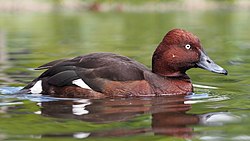This article needs additional citations for verification .(December 2020) |
| Nagi Bird Sanctuary | |
|---|---|
IUCN category IV (habitat/species management area) | |
 Landscape of Nagi Bird Sanctuary | |
 | |
| Location | Jamui, Bihar, India |
| Nearest city | Deoghar |
| Coordinates | 24°49′03″N86°24′00″E / 24.81750°N 86.40000°E |
| Area | 207 hectares (510 acres) |
| Designation | Important Bird Area |
| Created | 1984 |
Nagi Bird Sanctuary is located in Jhajha Jamui district of south Bihar, near the Jharkhand border. It was declared a bird sanctuary on 25 February 1984 as per Section 18 of the Wildlife (Protection) Act, 1972. The final notification under Section 26A of the act was issued on 4 September 2009. Thousands of migrating birds congregate in the reservoir during the winter season, especially from November to February. The area of the sanctuary is 2.1 square kilometres (0.81 sq mi). [1] It is home to over 133 bird species. There are also a variety of dragonflies, damselflies and butterflies which are yet to be studied and documented. In 2004, Nagi Dam Bird Sanctuary was declared an Important Bird Area (IBA) by BirdLife International. The area overlapping with the IBA is 791 ha. [2]
Contents
- Landscape
- Construction of Nagi Dam
- Declaration as Important Bird Area (IBA)
- Criteria for IBA
- Population of bar-headed goose beyond threshold
- Bird diversity
- Migratory birds
- Resident birds
- Fish diversity
- Threats to biodiversity
- See also
- References
The sanctuary is located 31 km from Jamui railway station and 12 km from Jhajha railway station. The nearest airport is 200 km away in Patna, although a new airport is coming up at Deoghar in northern Jharkhand. The highly revered Jain pilgrimage site of Lachhuar and temple city of Deoghar are 50 and 80 km away from the sanctuary respectively.










